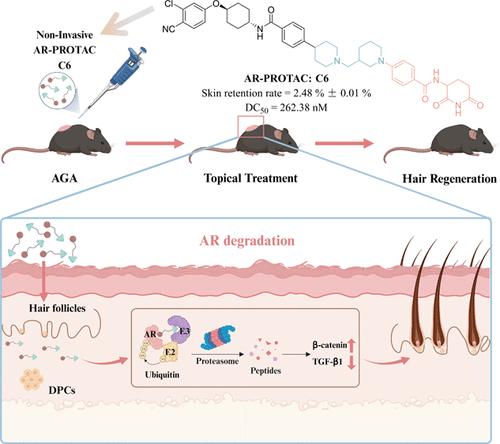发现一种用于局部治疗雄激素性脱发的新型无创AR PROTAC降解剂
IF 6.8
1区 医学
Q1 CHEMISTRY, MEDICINAL
引用次数: 0
摘要
雄激素受体(AR)蛋白表达水平升高和活性增强是雄激素源性脱发(AGA)发生的关键因素。AR蛋白水解靶向嵌合体(PROTAC)降解剂已显示出治疗潜力,但其皮肤渗透性差需要侵入性给药方法。在这项研究中,我们进行了结构特征分析,以研究AR PROTACs的不同连接体和E3配体对皮肤保留性能和降解效力的影响。其中,化合物C6具有优异的保肤性能和纳米摩尔水平的AR降解性能。C6通过降解AR,调节AGA相关的下游旁分泌因子的表达水平。此外,在非侵入性局部应用后,C6在AGA小鼠模型中表现出良好的皮肤积累并实现了毛发再生。总的来说,无创C6的发展为AGA治疗提供了一个有希望的新策略,并强调了使用PROTACs治疗其他皮肤疾病的潜力。本文章由计算机程序翻译,如有差异,请以英文原文为准。

Discovery of a Novel Non-invasive AR PROTAC Degrader for the Topical Treatment of Androgenetic Alopecia
Elevated expression levels and enhanced activity of androgen receptor (AR) proteins are key factors in the development of androgenetic alopecia (AGA). AR proteolysis-targeting chimera (PROTAC) degraders have shown therapeutic potential, but their poor skin permeability requires invasive delivery methods. In this study, we conducted a structure feature analysis to investigate the effects of different linkers and E3 ligands of AR PROTACs on skin retention properties and degradation potency. Among these, compound C6 was discovered with excellent skin retention properties and nanomolar level AR degradation. By degrading AR, C6 regulated the expression levels of downstream paracrine factors associated with AGA. Additionally, after non-invasive topical application, C6 demonstrated excellent skin accumulation and achieved hair regeneration in an AGA mouse model. Overall, the development of non-invasive C6 offers a promising new strategy for AGA treatment and highlights the potential for using PROTACs in treating other skin diseases.
求助全文
通过发布文献求助,成功后即可免费获取论文全文。
去求助
来源期刊

Journal of Medicinal Chemistry
医学-医药化学
CiteScore
4.00
自引率
11.00%
发文量
804
审稿时长
1.9 months
期刊介绍:
The Journal of Medicinal Chemistry is a prestigious biweekly peer-reviewed publication that focuses on the multifaceted field of medicinal chemistry. Since its inception in 1959 as the Journal of Medicinal and Pharmaceutical Chemistry, it has evolved to become a cornerstone in the dissemination of research findings related to the design, synthesis, and development of therapeutic agents.
The Journal of Medicinal Chemistry is recognized for its significant impact in the scientific community, as evidenced by its 2022 impact factor of 7.3. This metric reflects the journal's influence and the importance of its content in shaping the future of drug discovery and development. The journal serves as a vital resource for chemists, pharmacologists, and other researchers interested in the molecular mechanisms of drug action and the optimization of therapeutic compounds.
 求助内容:
求助内容: 应助结果提醒方式:
应助结果提醒方式:


